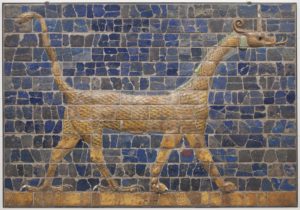During our Spring Break trip at the beginning of April, we visited the Detroit Institute of Arts. In addition to all that you might have expected to see at an art gallery, including a large gallery of religious art and sculpture from as far back as the medieval period, there was one section that really caused me to stop and think: an installation of ancient Near Eastern artifacts.
In this portion of the gallery were numerous cuneiform tablets, helmets, weapons, coinage, and mosaics. As my family and I moved through this section, I paid close attention to both the descriptions of the items as well as the dates ascribed to them. I began to point out to Aryn and the kids how specific items fit into the biblical timeline. Here was an Assyrian helmet that would have been worn by the soldiers of that empire when they were harassing the Northern Kingdom of Israel, eventually overtaking that kingdom as a result of its idolatrous ways. Then, over here was part of a mosaic that was from the city of Nineveh from about the time of Jonah. How amazing was it that we were standing in front of carvings from the walls of Nineveh that the reluctant prophet himself might also have seen? I was reminded of God’s grace for that city full of sinners, as well as Jonah’s sinful reluctance to share that grace with those people who were so different from him and who were his enemies. I took time to ask myself this question: “Are there groups of people who need to hear about the offer of salvation that God has made through Jesus Christ, but to whom I do not want that message to go?” It’s easy for us to divide the world into “us” and “them,” but in so doing, we are putting ourselves in the position to decide who is worthy of God’s grace. May it never be said of us!
 There were signet rings and seals that would have been used by officials of these various kingdoms around Israel and Judah; who knows if they might have been used to seal letters that were sent by courier between these ancient rulers? I showed my kids a dagger of the time period of Ehud, reminding them of that particularly graphic narrative from the Old Testament (Judges 3:12-20). But perhaps the artifact that caught my attention to the greatest degree (along with that section of the wall of Nineveh) was a large mosaic of the Mushhushhu-dragon, symbol of the Babylonian god Marduk. This large glazed ceramic mosaic adorned one of the gates into the city of Babylon and was dated 604-562 BC…exactly the time when so many of the mighty names from the time of the Babylonian Exile would have entered the city as captives: Daniel, Ezekiel, Hananiah, Mishael, and Azariah, to name a few.
There were signet rings and seals that would have been used by officials of these various kingdoms around Israel and Judah; who knows if they might have been used to seal letters that were sent by courier between these ancient rulers? I showed my kids a dagger of the time period of Ehud, reminding them of that particularly graphic narrative from the Old Testament (Judges 3:12-20). But perhaps the artifact that caught my attention to the greatest degree (along with that section of the wall of Nineveh) was a large mosaic of the Mushhushhu-dragon, symbol of the Babylonian god Marduk. This large glazed ceramic mosaic adorned one of the gates into the city of Babylon and was dated 604-562 BC…exactly the time when so many of the mighty names from the time of the Babylonian Exile would have entered the city as captives: Daniel, Ezekiel, Hananiah, Mishael, and Azariah, to name a few.
Again, I tried to imagine what it must have been like for those young boys, far away from their home and all that they knew, thrust into a pagan land. Images of these idols were everywhere, a direct violation of God’s commandments and surely a great offense to these faithful young men. They knew that their lives would never be the same at this point, but they also knew they served the mighty, sovereign, and loving God of the universe. While they might now be sojourners in a foreign land, they were not journeying through it alone. The Lord was with them (as He would make known in some really amazing ways not only to these Hebrew youth, but to the very kings of Babylon themselves). He would not leave them, no matter how dire the circumstances might seem (and fiery furnaces and lions’ dens are pretty dire!). Seeing these pieces reminded me of God’s great faithfulness no matter what may be going on around us in our culture. What a great and mighty God we serve! Just something to think about…

0 Comments